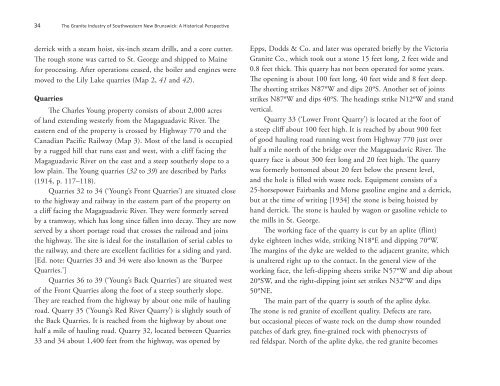The Granite Industry of Southwestern New Brunswick: A Historical ...
The Granite Industry of Southwestern New Brunswick: A Historical ...
The Granite Industry of Southwestern New Brunswick: A Historical ...
Create successful ePaper yourself
Turn your PDF publications into a flip-book with our unique Google optimized e-Paper software.
34 <strong>The</strong> <strong>Granite</strong> <strong>Industry</strong> <strong>of</strong> <strong>Southwestern</strong> <strong>New</strong> <strong>Brunswick</strong>: A <strong>Historical</strong> Perspective<br />
derrick with a steam hoist, six-inch steam drills, and a core cutter.<br />
<strong>The</strong> rough stone was carted to St. George and shipped to Maine<br />
for processing. After operations ceased, the boiler and engines were<br />
moved to the Lily Lake quarries (Map 2, 41 and 42).<br />
Quarries<br />
<strong>The</strong> Charles Young property consists <strong>of</strong> about 2,000 acres<br />
<strong>of</strong> land extending westerly from the Magaguadavic River. <strong>The</strong><br />
eastern end <strong>of</strong> the property is crossed by Highway 770 and the<br />
Canadian Pacific Railway (Map 3). Most <strong>of</strong> the land is occupied<br />
by a rugged hill that runs east and west, with a cliff facing the<br />
Magaguadavic River on the east and a steep southerly slope to a<br />
low plain. <strong>The</strong> Young quarries (32 to 39) are described by Parks<br />
(1914, p. 117–118).<br />
Quarries 32 to 34 (‘Young’s Front Quarries’) are situated close<br />
to the highway and railway in the eastern part <strong>of</strong> the property on<br />
a cliff facing the Magaguadavic River. <strong>The</strong>y were formerly served<br />
by a tramway, which has long since fallen into decay. <strong>The</strong>y are now<br />
served by a short portage road that crosses the railroad and joins<br />
the highway. <strong>The</strong> site is ideal for the installation <strong>of</strong> serial cables to<br />
the railway, and there are excellent facilities for a siding and yard.<br />
[Ed. note: Quarries 33 and 34 were also known as the ‘Burpee<br />
Quarries.’]<br />
Quarries 36 to 39 (‘Young’s Back Quarries’) are situated west<br />
<strong>of</strong> the Front Quarries along the foot <strong>of</strong> a steep southerly slope.<br />
<strong>The</strong>y are reached from the highway by about one mile <strong>of</strong> hauling<br />
road. Quarry 35 (‘Young’s Red River Quarry’) is slightly south <strong>of</strong><br />
the Back Quarries. It is reached from the highway by about one<br />
half a mile <strong>of</strong> hauling road. Quarry 32, located between Quarries<br />
33 and 34 about 1,400 feet from the highway, was opened by<br />
Epps, Dodds & Co. and later was operated briefly by the Victoria<br />
<strong>Granite</strong> Co., which took out a stone 15 feet long, 2 feet wide and<br />
0.8 feet thick. This quarry has not been operated for some years.<br />
<strong>The</strong> opening is about 100 feet long, 40 feet wide and 8 feet deep.<br />
<strong>The</strong> sheeting strikes N87ºW and dips 20ºS. Another set <strong>of</strong> joints<br />
strikes N87ºW and dips 40ºS. <strong>The</strong> headings strike N12ºW and stand<br />
vertical.<br />
Quarry 33 (‘Lower Front Quarry’) is located at the foot <strong>of</strong><br />
a steep cliff about 100 feet high. It is reached by about 900 feet<br />
<strong>of</strong> good hauling road running west from Highway 770 just over<br />
half a mile north <strong>of</strong> the bridge over the Magaguadavic River. <strong>The</strong><br />
quarry face is about 300 feet long and 20 feet high. <strong>The</strong> quarry<br />
was formerly bottomed about 20 feet below the present level,<br />
and the hole is filled with waste rock. Equipment consists <strong>of</strong> a<br />
25-horsepower Fairbanks and Morse gasoline engine and a derrick,<br />
but at the time <strong>of</strong> writing [1934] the stone is being hoisted by<br />
hand derrick. <strong>The</strong> stone is hauled by wagon or gasoline vehicle to<br />
the mills in St. George.<br />
<strong>The</strong> working face <strong>of</strong> the quarry is cut by an aplite (flint)<br />
dyke eighteen inches wide, striking N18ºE and dipping 70ºW.<br />
<strong>The</strong> margins <strong>of</strong> the dyke are welded to the adjacent granite, which<br />
is unaltered right up to the contact. In the general view <strong>of</strong> the<br />
working face, the left-dipping sheets strike N57ºW and dip about<br />
20ºSW, and the right-dipping joint set strikes N32ºW and dips<br />
50ºNE.<br />
<strong>The</strong> main part <strong>of</strong> the quarry is south <strong>of</strong> the aplite dyke.<br />
<strong>The</strong> stone is red granite <strong>of</strong> excellent quality. Defects are rare,<br />
but occasional pieces <strong>of</strong> waste rock on the dump show rounded<br />
patches <strong>of</strong> dark grey, fine-grained rock with phenocrysts <strong>of</strong><br />
red feldspar. North <strong>of</strong> the aplite dyke, the red granite becomes
















